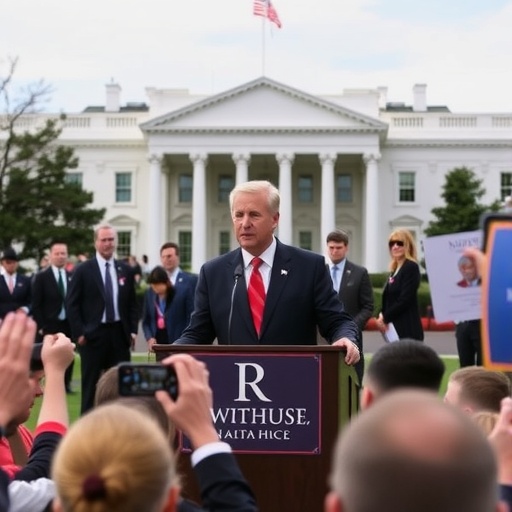Senate Republicans Rally at White House as Government shutdown Enters Fourth Week of Budget Stalemate
In a dramatic display of party solidarity, Senate Republicans converged on the White House today for a high-stakes meeting with President Trump, as the ongoing Government shutdown stretches into its fourth grueling week. With federal workers furloughed, national parks closed, and the economy feeling the pinch, the gathering underscores the deepening budget stalemate that shows no signs of breaking. Trump, flanked by key GOP leaders, reiterated his unyielding demand for border wall funding, vowing not to yield to what he called “Democratic obstructionism.” This rally comes amid mounting pressure from both sides of the aisle, yet neither Democrats nor Republicans appear ready to compromise, leaving millions in limbo.
The shutdown, now the longest in U.S. history, has furloughed over 800,000 federal employees and halted services from air traffic control to food safety inspections. As the clock ticks toward potential disaster relief delays and Social Security payment uncertainties, the White House meeting represents a pivotal moment. Senate Majority Leader Mitch McConnell and other Senate Republicans arrived en masse, signaling a unified front against Democratic proposals that exclude comprehensive border security measures.
Trump’s Border Wall Push Takes Center Stage in White House Talks
President Trump wasted no time in making his position crystal clear during the closed-door session at the White House. “We’re not backing down on the wall—it’s essential for national security,” Trump declared to reporters gathered outside the Oval Office, his voice booming with conviction. The meeting, which lasted over two hours, focused heavily on the $5.7 billion Trump has demanded for border barrier construction along the U.S.-Mexico frontier. Sources close to the discussions reveal that Senate Republicans expressed strong support, with several senators echoing the president’s frustration over what they perceive as partisan gamesmanship by House Democrats.
Senator Lindsey Graham (R-SC), a longtime Trump ally, emerged from the meeting to elaborate on the strategy. “This Government shutdown is painful, but it’s necessary to secure our borders. Democrats want open borders; we want safety for all Americans,” Graham stated, drawing applause from the Republican entourage. The session also touched on alternative funding mechanisms, including reallocating from military budgets or disaster aid, though no concrete agreements were announced. Trump’s insistence on tying the shutdown resolution to immigration reform has been a cornerstone of his administration’s agenda since the partial shutdown began on December 22, affecting nine of the 15 executive departments.
Inside the White House, maps of the border were reportedly spread across the table, with Trump pointing out hotspots for illegal crossings and drug trafficking. This visual aid seemed to galvanize the group, as one anonymous GOP aide noted, “The president painted a vivid picture of the chaos without the wall—it’s hard to argue against that passion.” Yet, critics argue this focus ignores broader fiscal priorities, like averting a debt ceiling crisis looming in the coming months.
Senate Republicans Draw a Line in the Sand Against Democratic Compromises
As the Senate Republicans filed into the Roosevelt Room, their resolve was palpable—a stark contrast to the fractured negotiations of prior weeks. Leader McConnell, often the quiet architect of GOP strategy, took a more vocal role today, telling attendees that any deal must include robust border protections. “We’ve compromised enough; it’s time for Democrats to meet us halfway,” McConnell said in a brief statement post-meeting. This unity rally is seen as a direct response to recent Democratic overtures, such as House Speaker Nancy Pelosi’s proposal for a clean continuing resolution without wall funding, which Republicans swiftly rejected.
The gathering included heavy hitters like Senators Ted Cruz (R-TX), Marco Rubio (R-FL), and John Cornyn (R-TX), who represent states most impacted by border issues. Cruz, fresh from a series of town halls in Texas, shared anecdotes from constituents terrified by rising fentanyl overdoses linked to cartel smuggling. “This isn’t politics; it’s lives on the line,” Cruz emphasized, linking the budget stalemate to real human costs. Data from U.S. Customs and Border Protection supports this narrative: in fiscal year 2018, agents seized over 17,000 pounds of fentanyl at the southwest border, much of it hidden in vehicles and pedestrian traffic.
Republican lawmakers also discussed internal polling showing their base’s unwavering support for Trump’s stance. A recent Quinnipiac University survey indicated that 45% of Republicans view the shutdown as a worthwhile price for border security, compared to just 12% of Democrats. This partisan divide has hardened positions, with Senate Republicans vowing to block any Senate vote on Democratic bills lacking immigration provisions. As one senator quipped off the record, “We’re dug in like ticks—ain’t moving until the wall’s funded.”
Human Impact Deepens: Federal Workers and Economy Feel the Shutdown Squeeze
Beyond the marble halls of Washington, the government shutdown‘s toll is hitting home for everyday Americans. In its fourth week, the impasse has led to $11 billion in lost economic output, according to a report from the Congressional Budget Office. Federal employees, many working without pay under the guise of “essential” status, are scraping by on savings or food bank handouts. Stories of air traffic controllers moonlighting as Uber drivers or Smithsonian curators facing eviction have flooded social media, amplifying calls for resolution.
Take TSA officer Maria Gonzalez, a single mother in Virginia, who shared her plight in a viral video: “I’ve served my country for 15 years, and now I’m choosing between groceries and gas.” Her story, retweeted by over 50,000 users, highlights the personal devastation amid the political posturing. Economists warn that prolonged disruption could shave 0.13 percentage points off GDP growth in the first quarter of 2019, with ripple effects in sectors like tourism—Yellowstone National Park alone lost $1.2 million in fees during the first two weeks.
The budget stalemate extends to critical programs: IRS tax refunds are delayed, affecting 10 million low-income filers reliant on early returns. Veterans’ benefits processing has slowed, irking even some Republican strongholds. In a letter to Trump, the American Federation of Government Employees urged immediate action, stating, “This shutdown is eroding trust in government at a time when unity is needed most.” Yet, White House officials counter that the economic pain is overstated, pointing to strong job reports as evidence of resilience.
Democratic Resistance Fuels White House Standoff with No End in Sight
While Senate Republicans rallied at the White House, Democrats remained steadfast in their opposition, framing the shutdown as Trump’s manufactured crisis. House Democrats passed four funding bills last week to reopen agencies piecemeal, but Senate Republicans bottled them up, adhering to Trump’s playbook. Pelosi, in a fiery floor speech, accused the president of holding the American people hostage: “This is not about a wall; it’s about power. We’ll negotiate on security, but not at the expense of dreamers or our democracy.”
Senate Minority Leader Chuck Schumer joined the fray, tweeting, “Republicans own this shutdown—Trump’s tantrum has gone on long enough.” Democratic strategists are betting on public backlash to force GOP concessions, citing polls where 53% of Americans blame Trump for the impasse (Pew Research Center). The party is pushing for a conference committee to hash out differences, but Trump has repeatedly threatened to veto any bill without wall money, creating a vicious cycle.
International observers are watching closely, as the U.S. government shutdown undermines America’s global image. Allies like Canada and Mexico have expressed concern over delayed trade talks, while adversaries exploit the chaos in propaganda. Back in D.C., whispers of a potential government reopening via emergency powers circulate, though legal experts deem it risky and unprecedented.
Looking ahead, the budget stalemate could spill into February, coinciding with the State of the Union address. Trump has hinted at delivering it amid the shutdown to underscore his resolve, but McConnell is pushing for a deal beforehand to avoid further embarrassment. Bipartisan talks, mediated by Vice President Mike Pence, are slated for next week, but skepticism abounds. If history is any guide—from the 1995-96 shutdowns to the 2013 standoff—prolonged gridlock often ends in last-minute compromises, but at what cost? As federal workers brace for another paycheckless weekend and markets jitter over fiscal uncertainty, the path forward remains as foggy as the Capitol dome on a winter morning. Stakeholders on both sides urge cooler heads, with one GOP strategist confiding, “We’re playing chicken, but someone’s got to swerve first.” The nation’s eyes are on Washington, waiting for that pivotal turn.










